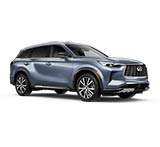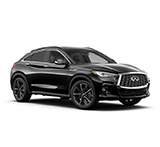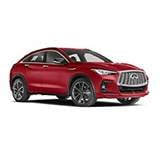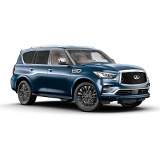Infiniti
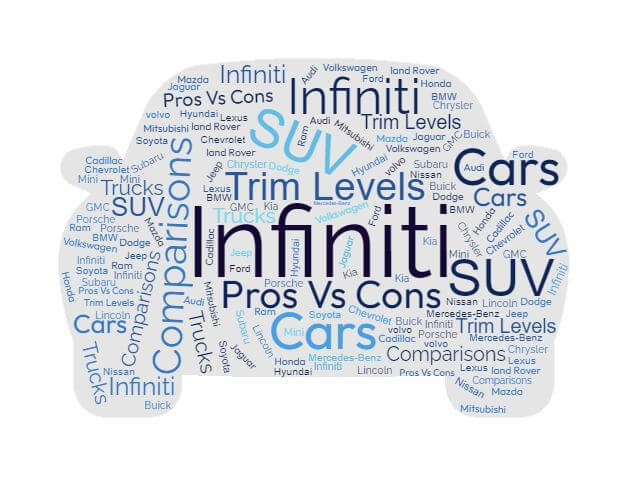
About Infiniti
1985 - The Journey BeginsThe Infiniti story starts way back in 1985. The initial concept was to develop a new premium brand that could compete with the established luxury car makes from Europe and the U.S. These included BMW and Mercedes-Benz along with Cadillac and Lincoln, respectively. Infiniti can also accurately be seen as Nissan's answer to Acura and Lexus -- the all-new luxury brands from its two biggest Japanese competitors (Honda and Toyota) that also bowed that decade.
Initially, Infiniti was intended exclusively for the North American market. This allowed Nissan to focus on the particular demands of American and Canadian buyers, without having to worry about the varying preferences of other markets. The "Horizon Task Force" was the name given to the team within Nissan that was responsible for devising the new luxury brand. Two key brand hallmarks the team quickly settled on was a focus on innovative, high-tech features and the importance of the overall ownership experience to luxury car buyers. The Horizon Task Force was also adamant that Infiniti models should be all new-designs, rather then rebadged versions of existing Nissan models.
Nissan launched its luxury brand for the 1989 model year. At the beginning, it had 51 total dealerships. Infiniti debuted with two models: the Q45 and the M30.
The Q45 was Infiniti's flagship full-size luxury sedan. Innovative and arguably a bit polarizing, it was a distinctive and memorable way to kick-off the new brand. In most major respects, the Q45 stood out noticeably from its contemporaries. Its exterior styling was sleek and modern with a decidedly high-end feel: nobody would mistake the big four-door sedan for just another Nissan. Its most eye-catching feature was its unusual grille-free nose. Some people loved it and others hated it, but to its designers' credit it was certainly a bold choice.
The Q45 was also an exciting and noteworthy vehicle underneath its sheet metal. Power was delivered by a muscular 278 horsepower V-8, which provided stand-out performance for its time. It shipped with a host of unique, high-tech mechanical systems, including a viscous limited-slip differential, a complex multi-link suspension configuration, four-wheel steering, and -- beginning in 1991 -- an electronically-controlled active suspension.
The M30 was a sporty mid-size coupe. It was based on the Japanese domestic market Nissan Leopard. Although the Leopard was unknown to North American buyers, this did betray Infiniti's initial resolve to avoid using rebadged versions of existing models. It was a decision, though, that Nissan management would continue to make in the coming years. In most respects, the M30 was not as unique or innovative as the Q45. It was met with somewhat disappointing sales.
By the mid-1990s, the Infiniti lineup had increased to three vehicles. Joining the Q45 was the compact G20 and the mid-size J30. The M30 was retired following the 1992 model year. Some blamed slow brand growth on Infiniti's somewhat obtuse early advertising efforts, which were interesting but often failed to show the actual cars for very long In reality, though, Nissan's luxury marque slowly but consistently began to develop a name for itself in the competitive North American market, even if progress was sometimes slow. The distinctive J30, with it's coupe-like profile and love-it-or-hate-it rear end, did a good job of building on the strong -- if a bit eccentric -- brand identity that the Q45 established in 1989.
2000 - Ready for the Twenty-First CenturyBy the turn of the millennium, Infiniti had grown from a relatively tiny upstart with just two models (one of which was a pretty resounding failure,) to an established player in the U.S. automotive landscape. Additional models -- including the entry-level I30/I35 mid-size sedan and the QX4 sport utility vehicle -- gave Nissan's premium brand the tools to compete on more even ground with Lexus and Acura. By 2000, Infiniti was consistently selling approximately 75,000 units each year.
2005 - A Luxury Brand on the RiseThe new millennium proved to be a good time for Infiniti. The sporty G35 coupe was a huge hit for the brand when it was introduced in 2002. The dramatically-styled and fun-to-drive two-door received great reviews from the automotive press and was enthusiastically embraced by buyers. Young, image-conscious professionals saw it as a genuinely desirable alternative to cars like the BMW 3-Series and Mercedes-Benz C-Class. It did a great job of reinvigorating public perception of Infiniti. Additional new models, such as the head-turning FX SUV, built on the brand's emerging reputation as the exciting, performance-focused Japanese luxury brand.
2015 - Going Global and Building on Its StrengthsOver the years, Infiniti gradually expanded its reach. While it began as a North America-only division, today you can buy a new Infiniti at one of over 230 dealerships in fifteen countries.
For the 2015 model year, the brand adopted a new alphanumeric naming scheme for all its vehicles. For instance, the G37 is now called the Q40. While this may be confusing to existing buyers, it demonstrate that Infiniti's decision makers are thinking hard about future strategy. The division's current lineup includes an expanding selection of sedans, coupes, and crossovers, as well as one convertible and one conventional SUV. A focus on leading-edge tech and performance-oriented driving excitement (along with a sometimes quirky sense of style) continue to differentiate Infiniti from its more staid Japanese luxury rivals.


